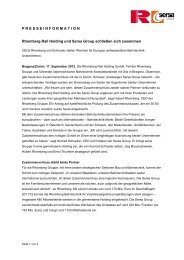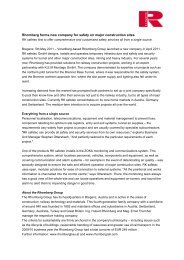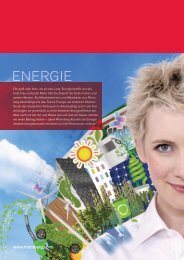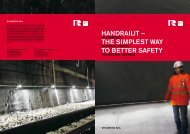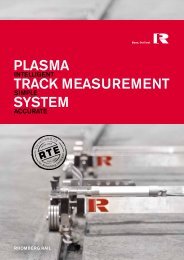Download "Universal Transition Module V-TRAS"
Download "Universal Transition Module V-TRAS"
Download "Universal Transition Module V-TRAS"
Create successful ePaper yourself
Turn your PDF publications into a flip-book with our unique Google optimized e-Paper software.
UNIVERSAL<br />
SIMPLE<br />
TRANSITION MODULE<br />
RELIABLE<br />
V-TRAS<br />
SUSTAINABLE<br />
RHOMBERG RAIL
V-tras –<br />
THE PERFECT<br />
CONNECTION BE-<br />
TWEEN DIFFERENT<br />
TRACK CONSTRUC-<br />
TION TYPES<br />
Some types of track construction, for example slab<br />
track and traditional ballast roadbed, differ greatly<br />
in their behaviour over time. The transition between<br />
sections of different track construction like these frequently<br />
develop defects during operation. The V-TRAS<br />
(versatile transition system) universal transition module<br />
is a simple, integrated and sustainable solution to<br />
this problem that can be used largely irrespective of<br />
whatever types of track construction are involved.<br />
CONSTRUCTION<br />
The V-TRAS universal transition module is a prefabricated,<br />
robust, ladder-form steel structure. One end sits on the<br />
termination of the slab track, while the rest of the module<br />
of a length chosen to suit the specific project is placed<br />
in the ballast roadbed, which provides it with a floating<br />
support. A conventional track grid consisting of traditional<br />
concrete sleepers and rails sits on this structure.<br />
The top surface of module has elastic bearings at the<br />
points in contact with the track grid to ensure optimum<br />
and durable support to the concrete sleepers.<br />
Once installed, the module is completely embedded in<br />
the ballast below the track grid and therefore ideally integrated<br />
into the track superstructure. No further measures<br />
are required.
ONE-SHOT<br />
SUSTAINABLE<br />
SOLUTION TO<br />
TRACK SUPER-<br />
AND SUBSTRUC-<br />
TURE PROBLEMS<br />
OPERATING PRINCIPLE<br />
ADVANTAGES<br />
The V-TRAS transition module works like a pontoon bridge.<br />
The end of the module sitting on the termination of the slab track<br />
cannot settle relative to the slab track because they are jointly<br />
supported at that point. However, the rest of the steel structure<br />
follows the settlement behaviour of the ballast roadbed. The two<br />
substantial longitudinal beams ensure that the differential settlement<br />
between the slab track and the ballast roadbed does not<br />
result in an abrupt change in level but takes the shape of a gradual<br />
ramp. The longitudinal beams contribute their stiffness rather<br />
than their strength, as the load is mainly transmitted through the<br />
sleepers and bearing surfaces directly into the ballast roadbed -<br />
very like what happens in conventional ballast track.<br />
Through the use of appropriately designed elastic bearings, the<br />
stiffness of the support to the track can be tapered between<br />
the slab track and the conventional ballast track.<br />
• Even distribution of differential settlement of sub- and<br />
superstructures (e.g. transitions between engineering<br />
structures and earthworks)<br />
• Can be used irrespective of slab track construction type<br />
• No special sleepers or other additional measures required<br />
• Precise and sustained determination of the settlement and<br />
stiffness characteristics through the use of durable elements<br />
(steel and elastomers)<br />
• Low number of different elements and therefore potential<br />
sources of defects<br />
• All the advantages of factory prefabrication<br />
• Use of conventional track construction methods<br />
• Simple rectification of installation errors and operational<br />
damage<br />
• No restrictions on incorporating additional track infrastructure<br />
• Large supported area results in low stresses in the elastic<br />
elements
Since 2001 RTE’s developments have expanded the competence<br />
profile of the Rhomberg Rail Group in the area of railway track<br />
systems and measuring technology. The team consists of a wide<br />
range of experts, which include construction engineers, surveyors,<br />
electronic engineers and software engineers. They develop and<br />
optimise complex systems for a variety of specialised disciplines.<br />
image processing, and microprocessor control systems) for<br />
outside companies. Our office in Salzburg is fully equipped with<br />
a test track and the necessary infrastructure to support CAD software<br />
and electronic developments.<br />
Marketing and sales is carried out by Rhomberg Rail Consult GmbH.<br />
The core competences of RTE Technologie GmbH are the development<br />
of track surveying systems and slab track railway systems.<br />
All these developments are characterised by their practical application<br />
as all systems have been tested and applied to in-house<br />
projects for the Rhomberg Rail Group. RTE Technologie GmbH<br />
also develops solutions in other technical areas (mechanical<br />
construction, software development, geometry tasks, digital<br />
Rhomberg Rail Consult GmbH<br />
info@rhombergrail.com<br />
Mariahilfstrasse 29<br />
6900 Bregenz/Austria<br />
Ph. +43 5574 403-0<br />
Engelbert Weiss Weg 2/B/4<br />
5020 Salzburg/Austria<br />
Ph. +43 662 421066<br />
www.rhombergrail.com




